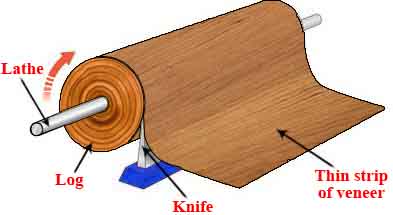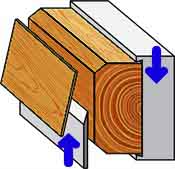
Wood veneer is the finest appearance of wood. Wood veneer is being cut in a very thin layer from tree log. Cutting the solid wood produces more waste than cutting veneer. Different ranges of veneers in shades, colours and textures are available in the market. They can be used in interior decoration. They are also used in the residential, hotel and office projects.
Methods of Veneer Cutting
The size of the log, the species of wood, the desired grain pattern and other factors determine which type of cut will be made to create wood veneer. There are distinct methods of cutting veneer from hardwood logs. Following are the various methods of veneer cutting:
01. Rotary Cut Veneer:

The log is rotated around its axis and peeled off like a carpet roll. Since this cut follows the log’s growth rings, a bold variegated grain marking is produced. The veneer sheets produce exceptionally wide. It is the least expensive veneer style. Rotary cut veneer is a cost effective method to obtain remarkable effects from birch, maple and oak.
02. Crown Cut Veneer:

Crown cut veneer is common veneer cutting method. The half log is positioned with the heart side against the flitch table. Slicing is done parallel to a line through its centre. This cut produces a light multicoloured and a distinctive pattern. The slices obtained by this method are always uniform. This method is moderately priced and is available for most species of wood.
03. Quarter Normal Cut Veneer:

This method of veneer cutting produces a series of straight lines. The quarter log is mounted on the flitch table such that the logs growth rigs hit the blade at the right angle.
04. Quarter Rift Cut Veneer:

In this cut, the rotation speed of the log is determined by the log size, its natural shape, particular features of the species of wood and the thickness of the veneer sheets. The cut is done at a slide angle from the position of the quarter log. This method results in a comb or rift grain effect.
From the above veneer cutting methods, different visual effects can be achieved with the wood’s grain and characteristics. This is the beauty of working with veneer that two logs of the same species of wood, cut in different ways, produce distinctive, individual veneers!
Also Read:
Different Types of Veneers Matching
Make a Right Choice Between Veneer and Laminate































